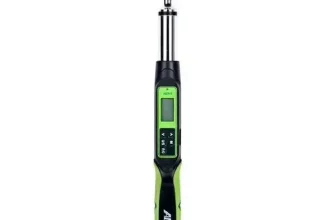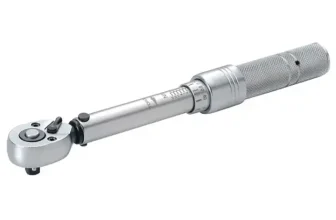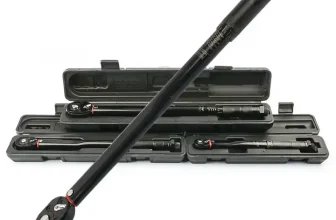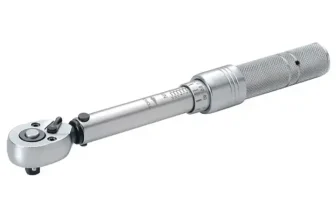Torque multipliers, as their name suggests, are tools designed to amplify the torque (or twisting force) applied by a user. They revolutionize the mechanics of applying torque to fasten or remove nuts and bolts, enabling one person to achieve a high torque output which would traditionally require multiple workers. Introduced in the early 20th century, these engineering marvels have transformed various industries, making tasks more efficient and reducing the physical strain on workers.
The principle of operation of these tools relies on the physics of leverage and gear ratios. By using a planetary gear set, the same type found in many automatic transmissions, torque multipliers make it possible to amplify the input torque — in layman’s terms, the amount of force applied to the tool — to generate a larger output torque at the other end. This torque magnification is typically denoted as a ratio, such as 4:1 or 5:1, meaning that for each unit of force applied, the tool produces 4 or 5 times that amount, respectively.
From automotive workshops to aerospace facilities and construction sites, torque multipliers have become indispensable where high torque is required, but space or physical constraints limit the use of a long wrench or a multiple operator system. Their diversity and flexibility have paved the way for numerous variants, each tailored for particular applications and requirements.
Brief explanation about Torque Multiplier Wrench
A torque multiplier wrench is a tool used extensively across various industries, especially where precise high-torque applications are required. It is a type of socket wrench which uses gears to amplify the force applied to the wrench, thereby multiplying the torque that can be generated. The tool is largely employed when the torque required for a particular task exceeds the capacity of a standard wrench or if the task demands a precise torque control. If you’ve ever operated a large piece of machinery or worked in an environment where hefty bolts require tightening or loosening, you’ve likely encountered a situation where a torque multiplier wrench proves indispensable. It takes mechanical advantage principle to a new level by offering an efficient yet straightforward means to apply controlled high-torque.
Fundamental Principles of a Torque Multiplier Wrench
The Physics of Torque
Torque, in layman’s terms, could be thought of as rotational force. Imagine how hard you would need to turn a stuck jar lid or how much effort it takes to crank a wind-up toy. Those actions involve torque, as you’re applying force in a circular motion. Contrary to linear force, which moves an object in a straight line, torque involves a pivot point or “fulcrum” around which the force is applied. A ‘moment’ or ‘moment of force’ might also be used to describe torque, which can be calculated as the product of the applied force and the distance from the fulcrum to the point where the force is enacted.
In mathematical terms, torque (τ) is typically measured in newton meters (N·m) and is calculated as the cross product of the radius vector (r) and the force vector (F):
τ = r × F
The direction of the torque vector is perpendicular to the plane formed by the radius and force vector, following the right-hand rule.
This physics principle quintessentially forms the foundation of a torque multiplier wrench, which is an embodiment of applied physics at its best. At its core, a torque multiplier wrench uses the principle of torque to maximize the force applied by an operator, effectively multiplying it to achieve a higher output torque, convenient for dealing with stubborn or high-torque fasteners.
Explanation of Mechanical Advantage Principle
The mechanical advantage principle is a fundamental concept in understanding how a torque multiplier wrench works. Essentially, the mechanical advantage refers to the factor by which a mechanism multiplies the force put into it.
In the context of a torque multiplier wrench, this principle is applied through leveraging some essential laws of physics. Lever arms and gears within the tool work in combination to multiply the inputted torque, or rotational force, leading to a higher outputted torque.
To put it in simpler terms, if you apply a certain amount of rotational force to the torque wrench, the mechanical advantage principle will multiply that force, resulting in a greater torque on the output side. This is particularly useful for loosening or tightening nuts and bolts that require an amount of force exceeding the strength of an average user.
The effectiveness of a torque multiplier wrench lays in its ability to provide greater torque without needing extra effort from the user, therefore offering an efficient method to perform tasks more easily and accurately. The underlying principle for this remarkable efficacy is, undeniably, the principle of mechanical advantage.
Anatomy of a Torque Multiplier Wrench
List of Key Components
A torque multiplier wrench is not a simple tool but quite a dynamic one. Made up of several components, each plays a crucial role in its function. Here are the key pieces that comprise the tool:
- Input Shaft: Known as the drive input, the input shaft is where you attach your wrench or ratchet to apply the initial torque.
- Output Shaft: This is the drive output where you attach the socket. It transfers the multiplied torque to the object that needs to be manipulated.
- Gear Assembly: This is the heart of the tool and what makes the multiplication of torque possible. It consists of several sets of gears that multiply the force applied at the input shaft. The gearing ratio determines the multiplication.
- Reaction Bar/Handle: This element helps the tool stay steady during usage. When you put force on the input shaft, the reaction bar presses against a solid object to prevent the entire tool from turning.
- Casing: This covers and protects the internal parts of the tool. It’s often made of durable materials, like steel, to withstand the pressures applied.
Detailed Description of each part and its function
A torque multiplier wrench is ingeniously constructed with several key components, each serving a vital role.
- Input Shaft: The input shaft is the part where the force is initially applied. It is connected to a wrench or a socket and should be held tightly while applying force.
- Output Shaft: This is the component that ultimately transfers the multiplied force to the nut or bolt that needs turning. The output shaft usually features a socket connection of 1/2″, 3/4″, and 1″.
- Gear System: Perhaps the most significant part, the gear system within a torque multiplier wrench is responsible for the actual multiplication of torque. This system consists of two types of gears – the input gear and the output gear. The input gear is smaller and turns more times for one revolution of the output gear due to gear ratio difference. This difference in rotations results in force multiplication.
- Reaction Bar/Arm: As the input shaft turns under force, the entire system could turn as well, presenting a practical problem. The reaction bar (or arm) anchors the torque multiplier wrench to a steady surface, keeping it from turning and ensuring the torque is transferred correctly.
- Housing: The housing or casing is the external cover that protects the internal components of the torque multiplier wrench. It is sturdy, durable and bears the brunt of any mechanical strain applied to the tool.
- Bearings: Bearings lie between the rotating parts, which help reduce friction and maintain the smooth operation of the tool whenever in use.
Understanding the anatomy of a torque multiplier wrench allows for efficient use and can help in diagnosing any issues that might occur during its operation.
How a Torque Multiplier Wrench Functions
Step-by-step explanation of the Torque multiplication process
The torque multiplication process in a Torque Multiplier Wrench is a fascinating one. It begins when a user applies force or torque at the input end of the wrench. The input torque then travels to the drive handle of the wrench, which is connected to an input gear.
This input gear has a lower number of teeth in comparison to the output gear. Consequently, when the input gear, connected to the handle, rotates, it results in the slower rotation of the larger output gear due to the gear ratio. This is a prime example of the simple gear mechanism where a high speed low torque drive is transformed to a low speed high torque output.
Following this, the fast rotation of the smaller gear (input gear) against the slower rotation of the larger gear (output gear) creates a mechanical advantage leading to the multiplication of the torque applied. Now, the output gear is connected to the output square drive, which is often connected to a socket or any other types of tool.
This process results in the increased torque force at the output end of the wrench, effectively enabling the user to exert large amounts of torque with significantly less force to the handle. In this way, a Torque Multiplier Wrench significantly enhances the user’s capacity to tighten or loosen fasteners that require high torque levels.
It’s important to note that the multiplication factor is determined by the gear ratio of the tool. Hence, different Torque Multiplier Wrenches have different multiplication capacities-dependent on their specific gear arrangements.
Parameters that influence the amount of Torque multiplication
Several parameters can influence the amount of torque multiplication when using a torque multiplier wrench.
The first and most straightforward parameter is the torque input. This refers to the amount of torque that you apply to the torque multiplier wrench’s input shaft. Naturally, the more torque you apply, the more will be outputted, given a constant torque multiplication ratio.
The second parameter is the multiplication ratio of the torque multiplier wrench itself. This ratio varies depending on the specific design of the wrench and its intended use. It represents the multiple of the applied torque that the wrench can output. For example, a multiplier with a 4:1 ratio will output four times as much torque as is applied to its input shaft.
The efficiency of the torque multiplier wrench is another crucial parameter. Not all the applied input torque can always be converted into output torque. Some of it will be lost due to factors like friction and heat. Hence the efficiency, typically expressed in percentage, represents the actual proportion of input torque converted into output torque.
Lastly, environmental parameters can also influence the amount of torque multiplication. Factors like the temperature and the operational condition of the wrench can affect its function. Higher temperatures can increase material flexibility, affecting the multiplication ratio, while a poorly maintained wrench might not be as efficient.
Understanding these parameters could enable users to use a torque multiplier wrench more effectively and efficiently.
Various Types of Torque Multiplier Wrenches
Based on Configuration and Design
Torque Multiplier Wrenches, like many other tools, come in a variety of configurations and designs to better suit the specific needs of each task. There are essentially three main categories of designs for Torque Multipliers: in-line, angled, and radially dispersed.
The in-line configuration is the most traditional and straightforward design. As its name implies, the input and output shafts of this design are arranged in a linear fashion. This, in theory, makes the tool easier to use and handle as it somewhat mimics the natural movement of tightening and loosening bolts or fasteners.
Angled Torque Multiplier Wrenches, on the other hand, have their input and output shafts arranged in an acute angle. This makes these torque multipliers perfect for situations where space is severely limited, as the angled configuration allows the user to navigate around obstacles.
The radially dispersed torque multiplier, which has its input and output shafts arranged in a radial or circular manner, is becoming increasingly common due to its ability to distribute torque uniformly in a whole circular path.
In addition to these designs, some Torque Multiplier Wrenches come with a reaction arm – a rigid bar that holds the tool in place against the rotational force of the output when the input is turned. The presence or absence of a reaction arm, its length, and ease of adjustment can all significantly impact the practicality and efficiency of a Torque Multiplier Wrench in different applications.
The available configurations and designs essentially ensure that for any bolting or unbolting need, there will be a suitable Torque Multiplier Wrench available. Understanding the differences in configuration and design can help users choose the ideal tool for their specific needs.
Based on Torque ratio
Torque multipliers are categorized based on their torque ratio, which differentiates the degree of torque amplification they can produce. This ratio denotes the mechanical advantage a torque multiplier wrench offers and indicates the multiplication of the effort (or input torque) exerted.
A 1:5 torque ratio, for instance, means that for every one unit of force applied to the wrench, five units of force are generated on the nut or bolt being turned. In practice, this means that an applied force of 20 newton meters would generate an output force of 100 newton meters at the nut or bolt. This significant enhancement allows for easy loosening or tightening of tough fixtures, making the job considerably easier and efficient.
Conversely, a higher torque ratio like 1:50 implies that for every one unit of force applied, 50 units of force will be produced at the working end. This vast increase in force multiplication is required for particularly stubborn nuts and bolts, or for jobs requiring a high degree of precision.
In essence, the type of torque multiplier wrench chosen will depend on the desired torque ratio. The decision will depend on the specific job requirements – higher torque ratios for larger or particularly resistant bolts, and lower torque ratios for smaller or standard fixtures. Thus, torque multiplier wrenches with different torque ratios have distinct uses and applications, allowing these tools to be adapted to a wide range of tasks.
Applications of a Torque Multiplier Wrench
Listing and explanation of the areas where it is commonly used
A Torque Multiplier Wrench is an indispensable tool used across numerous fields for its unique ability to amplify output torque. To have a comprehensive understanding of this tool’s relevance, below are a few key areas where a Torque Multiplier Wrench is most commonly utilized:
- Automotive Industry: A primary use of the torque multiplier is within the automotive industry, specifically in areas such as wheel tightening. Large vehicles such as trucks, buses, and tractors often require a high torque to fasten or loosen their lug nuts. Using a torque multiplier wrench in these situations ensures work efficiency and the adherence to specified torque requirements.
- Aviation: Torque multipliers also find significant usage in aviation, especially when performing maintenance work on aircraft engines. Here, they facilitate the tightening and loosening of bots on airplane engines, which demand high torque forces that often cannot be achieved with standard tools.
- Heavy Machinery: The versatility of a torque multiplier wrench extends to industries working with heavy machinery like mining equipment, oil rigs, power plants, and shipbuilding. The large, robust bolts and nuts in this equipment require substantial torque for disassembly, maintenance, or replacement.
- Construction: In the construction world, a torque multiplier wrench is frequently utilized for steel erection and suspension bridges, where bolts need to be tightened with high levels of torque force.
- Manufacturing: In the manufacturing sector, it’s all about precision. To ensure product quality and safety, a torque multiplier wrench is used to apply precise, high levels of torque where required.
In these distinct fields, a torque multiplier wrench delivers multiple benefits including accuracy, speed, control, and work efficiency, thus making it a staple in many toolkits. It is a tool that can deliver levels of torque unachievable by conventional hand force, making it essential in sectors requiring high torque application.
Benefits of using a Torque Multiplier Wrench
A torque multiplier wrench offers numerous benefits that make it a valuable tool in different fields. These advantages include:
- Increased Torque Output: The primary advantage of a torque multiplier wrench is its ability to increase the torque applied to a nut or bolt. This is especially beneficial for large scale operations where a regular wrench may not be enough to secure or remove fasteners.
- Reduced user exertion: By multiplying the force applied, this tool significantly lessens the physical strain for the user. This is particularly impactful in industries where fastening or unfestening tasks are repetitive or strenuous, thus leading to less fatigue and a safer work environment.
- Enhanced accuracy and precision: The torque multiplier wrench provides an accurate and consistent torque output. It allows for precise tightening, which is crucial in industries where imprecise torque could result in dangerous or expensive defects.
- Versatility: A torque multiplier wrench can cater to a variety of fastener shapes and sizes, making it a diverse tool with broad applications in different fields such as automotive industries, aerospace, manufacturing, and heavy machinery sectors.
- Reduced dependency on power tools: Traditional high-torque tasks may require power tools which can be expensive, hard to maintain, and often require electricity or batteries to operate. A torque multiplier wrench, on the other hand, uses simple mechanical principles, reducing dependency on power tools.
- Improved accessibility: Torque multiplier wrenches are often more compact than equivalent power tools, making them ideal for working in tight or confined spaces where heavier machinery may struggle.
By offering better physical efficiency and technical precision, torque multiplier wrenches provide clear advantages over traditional wrenches in various work settings.
Safety Measures in Using a Torque Multiplier Wrench
Work Safety Protocol
Utilizing a torque multiplier wrench requires strict adherence to safety protocols, largely due to the high amount of force that it can generate. Proper protective gear is one of the cardinal rules when working with this tool. This includes safety eyewear to shield from potential debris, gloves for improved grasp, and steel-toe boots to safeguard against potential dropped tools.
Before using the torque multiplier wrench, always perform a quick inspection of the tool, ensuring it’s free from any visible damages. Remember, a damaged or flawed tool can lead to accidents or ineffectual results. As a rule of thumb, only use the tool when it’s in optimum condition.
Once ready to work, secure the part you are working on to prevent unnecessary movement, which can lead to inaccuracies or accidents. Stability is crucial when using tools that produce high torque. Also ensure that the socket of your multiplier correctly corresponds to the fastener’s size to avert slippage or damage.
While using the torque multiplier wrench, apply regular and steady pressure. Avoid ‘jerking’ or sudden, irregular motions, as these might lead to an over-application of torque or even injury. Adjustment of the output torque must be done as per the specifications for the fastener you are dealing with.
Lastly, keep bystanders at a distance when operating the torque multiplier wrench and keep your work area clean and orderly to avoid tripping hazards. These steps will help in maintaining a safe and effective working environment.
Maintenance
A well-maintained Torque Multiplier Wrench ensures optimum performance, long lifespan, and most importantly, the safety of its user. When considering maintenance for this tool, the first step is the consistent cleaning of the Torque Multiplier Wrench. Debris or grit that get lodged inside can affect the tool’s operation and may potentially lead to tool failures.
Another vital part of maintenance is regular inspection. There should be a periodic check on the condition of the gears, the reaction plate, and the handle. Any noticeable wear and tear should be tended to immediately. The gearbox also needs consistent lubrication to prevent friction, which can produce excessive heat. This heat can deform the parts of the mechanism, which could lead to reduction in its efficiency, or in worse cases, tool failure and accidents.
Next, to ensure consistent accuracy, it should also be recalibrated periodically as per the manufacturer’s instructions. Mis-calibrated tools can significantly affect the amount of torque applied and subsequently compromise the integrity of the fastened object.
Lastly, users must ensure that they only use torque multipliers for their intended torque range as specified by the tool’s manufacturer. Using the tool beyond its prescribed range can cause overloading, which could lead to breakdown of the tool or injury to the user.
In conclusion, maintenance for a Torque Multiplier Wrench involves cleaning, inspection, lubrication, recalibration, and using it within its intended range for safe and extended use.
Conclusion: The significance of a Torque Multiplier Wrench in various fields
Recap of primary points
Throughout this article, we dove into the remarkable subject of Torque Multiplier Wrenches, a crucial tool with significant utility in various industries. We first began to understand what a torque multiplier is, and how it’s uniquely designed as a wrench to enhance the torque produced by a user.
We learned about the basic principles that govern its operation, such as the physics of torque and the principle of mechanical advantage. We then peeled back the layers of a Torque Multiplier Wrench to uncover its anatomy, identifying and explaining key components and their respective functions.
Following this, we demonstrated how this tool multiplies torque, covering the step-by-step process and the factors that influence the amount of multiplication. Furthermore, we examined different types of torque multiplier wrenches, classified based on their design and torque ratio.
We also uncovered its areas of application, ranging from automotive repair to heavy machinery and construction, highlighting the benefits it offers such as reduced manual labor and increased precision. Importantly, we also discussed the safety measures to bear in mind when using this tool from workplace protocol to its maintenance needs. Through this overview, it’s clear that the torque multiplier wrench plays a pivotal role in multiple fields, enhancing efficiency and productivity.
Closing thoughts on the importance and implications of the tool in the industry.
The torque multiplier wrench not only exemplifies the sheer brilliance of simple physics transformed into a practical tool, but is also an invaluable asset across various industries. Its ability to amplify input force makes it an indispensable tool for scenarios where high torque application is required but space is limited or human strength is not sufficient. The multiplier wrench allows for precision, reducing the risk of damage to parts or bolts due to over-tightening, thus improving the safety and durability of mechanical work.
Its configurations offer variability in torque multiplication, making the tool adaptable to a myriad of applications – from automotive, aviation, industrial maintenance to construction. It is important to remember that any simple tool can become extraordinary when applied with science and understanding.
So, whether you’re tightening the nuts on car wheels, assembling giant industrial machinery or maintaining an aircraft, the torque multiplier wrench subtly emphasizes science and its practicality in our everyday life – proving once again that greatness often hides in the simplicity of design and function. We hope this article provides helpful information about this incredible tool, and we encourage everyone to respect and understand the science behind it. Because in the grand scheme, properly used knowledge combined with the right tools make the world a safer and more efficient place.







